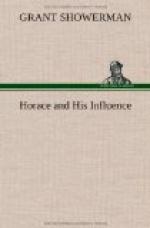The momentum of intellectual interest is not lost in the eleventh century. Paris becomes its most ardent center, with Reims, Orleans, and Fleury also of note. The Codex Parisinus belongs to this period. German activity, too, is at its height, especially in the education of boys for the church. Italy affords one catalogue mention, of a Horace copied under Desiderius. Peter Damian was its man of greatest learning, but the times were intellectually stagnant. The popes were occupied by rivalry with the emperors. It was the century of Gregory the Seventh and Canossa.
In the twelfth century came the struggle of the Hohenstaufen with the Italian cities, and the disorder and turmoil of the rise of the communes and the division of Italy. One catalogue shows a Horace, and one manuscript dates from the time. England and France are united by the Norman Conquest in much the same way as Germany and France had been associated in the kingdom of Charlemagne. It is the century of Roger Bacon. Especially in Germany, England, and France, it is the age of the Crusades and the knightly orders. It is an age of the spread of culture among the common people. In France, it is the age of the monastery of Cluny, and the age of Abelard. Education and travel became the mode. In general, acquaintance with Horace among cultivated men may now be taken for granted. The Epistles and Satires find more favor than the Odes. Five hundred and twenty citations of the former and seventy-seven of the latter have been collected for the twelfth century.
The thirteenth century marks a decline in the intellectual life. The Crusades exhaust the energies of the time, and detract from its literary interest. The German rulers and the Italian ecclesiasts are absorbed in the struggle for supremacy between pope and emperor. Scholasticism overshadows humanism. The humanistic tradition of Charlemagne has died out, and the intellectual ideal is represented by Vincent of Beauvais and the Speculum Historiale. There is no mention of Horace in the catalogues of Italy. The manuscripts of France are careless, the comments and glosses poor. The decline will continue until arrested by the Renaissance.
It must not be forgotten that among all these scattered and flickering attentions to Horace there was the constant nucleus of instruction in the school. That he was used for this purpose first in the Carolingian cloister-schools, and later in the secular schools which grew to independent existence as a result of the vigorous spread of educational spirit, cannot be doubtful. Gerbert, dying at the beginning of the eleventh century as Pope Sylvester II, is known to have interpreted Horace in his school. This is the oldest direct evidence of the scholastic use of Horace, but other proofs are to be seen in the commentaries of the medieval period, all of which are of a kind suitable for school use, and in the marginal annotations, often in the native tongue.




